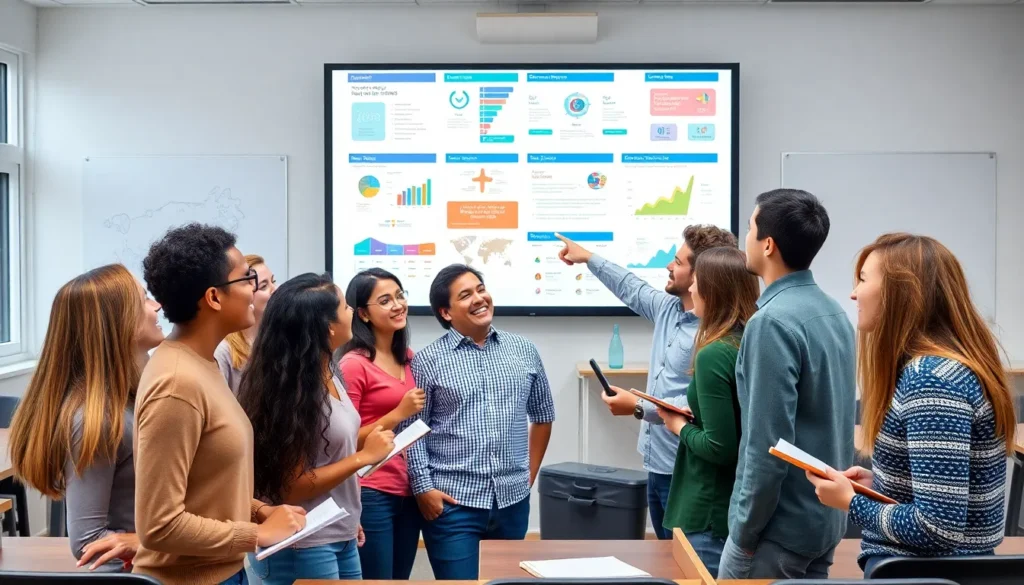Table of Contents
ToggleIn a world overflowing with information, visual learning tools stand out like a neon sign in a sea of gray. They turn complex ideas into vibrant images, making learning not just effective but downright enjoyable. Who wouldn’t prefer a colorful infographic over a dense textbook? It’s like trading in a salad for a pizza—both can be nourishing, but one’s just way more fun.
Overview of Visual Learning Tools
Visual learning tools play a crucial role in enhancing the educational experience. These tools simplify complex subjects, allowing learners to easily grasp concepts through engaging visuals.
Importance of Visual Learning
Visual learning boosts comprehension and retention of information. Research indicates that people remember 65% of visually presented content compared to just 10% of written text. Learners benefit from the clarity that visuals provide, which helps in breaking down intricate topics into digestible parts. Engaging with graphics stimulates creativity and encourages deeper understanding of material. The use of diagrams, charts, and images fosters a more interactive learning environment, catering to diverse learning styles.
Types of Visual Learning Tools
Several types of visual learning tools exist to aid education. Infographics present data in a visually appealing format, making it easier to understand statistics. Mind maps organize information visually, facilitating brainstorming and outlining ideas. Videos and animations offer dynamic explanations of concepts, allowing for visual storytelling. Charts and graphs effectively summarize complex data, illuminating patterns and trends. Virtual reality experiences immerse learners in interactive environments, enhancing engagement and practical understanding. Each type of tool serves unique purposes, appealing to various educational needs.
Benefits of Visual Learning Tools


Visual learning tools provide significant advantages in the educational landscape. They simplify and clarify concepts, leading to improved learning experiences.
Enhancing Retention Rates
Retention rates improve considerably with the use of visual aids. Research indicates that people remember 65% of information presented visually, compared to 10% of text-only content. This substantial difference underscores the effectiveness of visuals in enhancing memory. Engaging formats like infographics and videos capture attention, encouraging learners to retain information longer. Using diagrams or flowcharts allows learners to visualize relationships between concepts, reinforcing understanding. Consequently, learners are more likely to recall information when needed, benefiting their educational outcomes.
Supporting Diverse Learning Styles
Visual learning tools cater to various learning styles effectively. Some learners grasp concepts better through images and graphics than through text alone. For instance, visual learners thrive on diagrams, while auditory learners benefit from video content. Utilizing a mix of tools accommodates these differing preferences, creating a more inclusive learning environment. Mind maps serve as excellent resources for organizing thoughts, fostering deeper comprehension for those who prefer visual organization. Additionally, interactive tools like virtual reality provide immersive experiences that further engage learners. Adapting resources to suit diverse needs enriches the overall educational experience for every learner.
Popular Visual Learning Tools
Various visual learning tools enhance comprehension and retention, appealing to diverse learning styles. Here are some key tools that effectively support visual learning.
Infographics and Charts
Infographics and charts present data visually, turning complex information into easily digestible content. These tools combine images and text, allowing learners to grasp essential concepts quickly. Research shows that visuals boost memory retention, engaging learners more effectively than traditional methods. Popular tools like Canva and Piktochart simplify infographic creation, while software like Microsoft Excel aids in chart design. Adding color and relationships between elements further enhances their educational value.
Mind Mapping Software
Mind mapping software organizes thoughts and ideas visually, aiding in concept retention and clarity. Tools like MindMeister and XMind help users create dynamic maps, allowing for easy manipulation of ideas. With a central concept at their core, these maps branch out into related topics, visually depicting relationships. Users can incorporate images, colors, and links for a more engaging learning experience. This approach cultivates a comprehensive understanding, making it ideal for brainstorming sessions and study aids.
Video and Animation Tools
Video and animation tools offer dynamic content that captures attention and facilitates learning. Platforms such as Animaker and Powtoon enable users to create engaging animated videos. These formats can illustrate concepts that text alone cannot convey, bringing subjects to life. Audio-visual elements in videos help reinforce learning and improve retention rates. Incorporating a mix of storytelling and visuals engages learners, making it easier to absorb complex materials.
How to Integrate Visual Learning Tools in Education
Integrating visual learning tools enriches educational experiences and enhances understanding. Implementing effective strategies and tips ensures an optimal learning environment for both teachers and students.
Strategies for Teachers
Adopting visual learning tools in the classroom starts with recognizing diverse learning needs. Encourage the use of infographics to represent complex data; this method simplifies information and makes it more digestible. Utilizing interactive mind maps can help students organize their thoughts and ideas visually, aiding comprehension. Incorporate videos and animations into lessons; this dynamic content captivates students and reinforces learning. Providing opportunities for collaborative projects using visual aids allows learners to engage actively, fostering teamwork and communication skills.
Tips for Students
Students should take initiative by utilizing visual aids to boost their studying efficiency. Creating vivid mind maps assists in the organization of information; this method enhances memory retention. Engaging with infographics during research clarifies complex topics, making learning enjoyable. Watching educational videos can provide additional context and reinforce concepts; students should prioritize this resource for deeper understanding. Lastly, actively participating in discussions centered around visual tools enriches the learning experience, encouraging diverse perspectives and insights.
Visual learning tools have proven to be invaluable in today’s educational landscape. They not only simplify complex concepts but also engage learners in a way that traditional methods often fail to achieve. By incorporating various tools like infographics, mind maps, and videos, educators can cater to different learning styles and enhance comprehension.
The effectiveness of these tools is evident in their ability to improve retention rates and make learning more enjoyable. As education continues to evolve, embracing visual aids will be essential in fostering a deeper understanding and encouraging active participation among students. Ultimately, the integration of visual learning tools paves the way for a more dynamic and effective educational experience.







